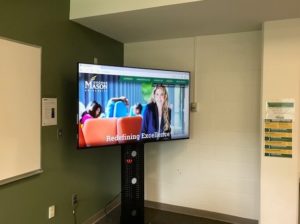Rooms: East 121, East 134, Krug Hall 209
Classroom Features, Technology Instructions, and Teaching Tips
Typical Room View: For precise room capacity and photos showing the furniture and layout of your exact classroom, please log in to 25Live and click on the Locations tab. (You may need to create a 25Live account.)
Classroom Features
- TV Monitor
- Laptop/tablet required for connection (HDMI)
- FAQs and Troubleshooting
Technology Instructions and Teaching Tips
Show All | Hide All
TV MonitorInstructions
- Press the power button to turn the display on.
- Use the side buttons on the monitor for volume and input control.
- If needed, press and release the input button repeatedly until “HDMI1” is displayed on the screen.
- Audio is provided via the internal speakers on the monitor.
Supporting Active and Engaged Learning
- Survey or quiz your students in real time to see if they’re getting it: Since most students carry a mobile device, you can use a free or low-cost tool (Kahoot, PollEverywhere, Quizlet, etc.) to project a question on the screen and collect students’ responses anonymously during class. For additional learning, try a three-step process: ask a question and gather initial answers; have students consult with a partner about their answer; ask the same question again. (The best part is not that more students answer correctly, but that many students have explained or understood why the right answer is right.)
- Collaborate with your students: Using OneDrive, you can share a link with multiple students so they can use their own devices to contribute to a Word, Excel, or PowerPoint document that you display on screen. (This may work best if you edit in your browser; your students won’t need any special software or accounts.) Your students could help you identify resources about recent economic data, brainstorm solutions to a health services problem, compose a database of their favorite movies, or list questions for an upcoming guest speaker. Often collaborative editing allows quiet students to contribute in ways that spoken discussion might not.
- For more teaching tips and examples, visit the Stearns Center’s Active Learning page.
Instructions
- Locate the HDMI cable on the TV monitor.
- Connect your source device (laptop, tablet, etc.) to the system with the HDMI cable (Some devices may require an adapter, or dongle, to accept the HDMI cable.)
- Faculty may check out laptops and/or adapters for temporary use from Classroom Support Services in The Mix at Fenwick Library. For longer-term use, please consult your department.
- To troubleshoot issues related to sound and/or image display, see the FAQ page.
Supporting Active and Engaged Learning
- Reporting out from activities: Invite individual students or teams to connect their device to the console to share the results of an in-class activity. After in-class work, not all participants or teams need to report out (this can get tedious), but asking a few to share increases accountability and helps spark discussion about the range of appropriate and innovative responses.
- Sharing student work: Invite individuals or teams to connect their device to share in-progress drafts of their research, designs, lab reports, or problem sets. Students who present informally and take questions gain confidence and may gain helpful feedback or insight; more importantly, others in the class see real-time problem-solving from their peers and are often reassured that not everyone gets it right the first time. Help students focus their comments on how the document/problem could be improved and what they themselves can learn from it (rather than commenting on the abilities of the student presenting).
- For more teaching tips and examples, visit the Stearns Center’s Active Learning page.

